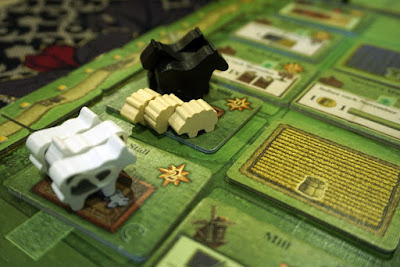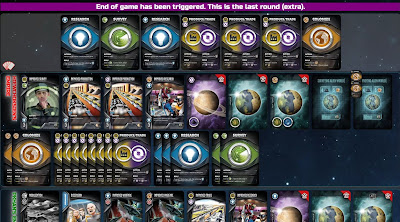Saturday, 25 June 2022
Fields of Arle
Friday, 17 June 2022
Alphameet playtesting event
I went to the May 2022 Alphameet organised by TTGDMY (Table Top Game Designers Malaysia). Alphameets are for game designers to come together to playtest one another's prototypes. They are more about playtesting, giving feedback and exchanging ideas, and less about purely playing games. I brought quite a few prototypes and managed to get two of them played. My games tend to be simple and short, and the convention at Alphameets is to play shorter games first. So I got to play my games earlier. I have only participanted in an Alphameet just one other time. Back then I could only join late in the event, and I missed most of the activities. This time I managed to join at the start. It was a small event this time. We only had two tables.
The first game of mine I managed to get playtested was Snow White and the Seven Dwarfs. This was the first time I got it playtested. I didn't even have a proper prototype then. I used cards from a standard card deck. This game needs at least 5 players to be fun (I think), so it isn't something I can playtest easily at home with my daughter. Those who playtested it with me at the Alphameet seemed to enjoy it. We played two games back-to-back. I later decided to make a proper prototype, using drawings found on the internet. One of the game designers Jon who playtested Snow White later played it with his friends. They found it interesting and played for one an a half hours straight. That was certainly encouraging. I was moved that this little game borne of a simple idea brought joy to people.
Saturday, 11 June 2022
boardgaming in photos: REXKL, Star Realms, Ticket to Ride
Sunday, 5 June 2022
Eminent Domain
The game starts with everyone having a personal card deck which is exactly the same and one uncolonised planet. Your hand limit is five. On your turn you do two things. You play a card to perform an action (which is specified on the card), and then you play a card to select a role. Selecting a role means you perform an action related to the role. Other players get to follow you if they have the right cards, i.e. perform the same role, but as the active player you enjoy some privilege. Before you end your turn, you may discard cards from your hand. You then draw back up to your hand limit. If you have more cards than allowed, you have to discard down to your hand limit. What you do on a turn is quite simple.
Let's talk about the roles. There are five. When you pick a role, you claim a role card from the centre of the table. This becomes your card and it boosts your action. This is how you augment your deck. The more you perform a certain role, your deck becomes better at that role, whether you like it or not. If you have multiple cards with the same role icon in your hand, you can play them all to boost your action. E.g. a planet may take 5 colonisation cards to colonise. If you happen to have 5 colonisation cards, you can play them all within one turn and complete the colonisation, as opposed to spending 2 or 3 turns doing it.
One important implication of claiming cards is the game ends when a certain number of common stacks run out. If many players decide to keep picking a certain role, the game may end quickly. The other way the game ends is when victory point chips run out. You claim victory point chips when you do trading.
The roles in the game are survey, colonise, warfare, product/trade and research. You survey to find new planets. You colonise or conduct warfare to capture planets. You use the same role to produce and later to trade. Earning victory point chips is a two-step process.
Doing research gets you new cards which are more powerful than the basic role cards. In addition to special powers, they also have role icons. So they can be used to boost role actions. It seems wasteful to use them for merely boosting a role action, as opposed to using their special powers, but sometimes it's worth it. It's better to look at it this way - tech cards give you an additional option.
Many of the tech cards have the same power, only the combinations of the role icons are different. This is a valid consideration when you decide what to research. In addition to the research cost, there is also a planet requirement when you research. E.g. you need to have two planets of the fertile type in your empire before you can research a particular tech. So research and colonisation / warfare are linked.
Some planets when added to your empire give you additional abilities. Some enable you to produce specific goods. Some give you a role icon, boosting your role action in future.
When the game ends, you score points for planets and techs. These are added to whatever you have scored from trading.
The Play























































